

Phone Wars: iPhone vs TyTN, Treo, Pearl, E62, P990, Q
Steve Job’s ambitious goal to grab a fifth of the smartphone market, coyly understated as ‘just 1% of the entire billion unit mobile phone industry’, indicates that Apple is looking at the industry very differently than every other vendor. While most phones are cheap or nearly free, the iPhone aims at the high end of smartphones.
Previous articles looked at how mobile providers’ phone subsidies distort pricing, and how smartphones relate to the rest of the mobile industry. Here’s a look at how the iPhone relates to other phones on the market.
Where Does the iPhone Fit?
Despite the iPhone being Apple’s first volley into into a crowded market, the company is pursuing an ambitious entry strategy. Rather than copying an existing successful product and a popular price point, the iPhone blazes a new trail in its combination of features and form factor, and does so at a significantly higher price.
When analysts pick at the iPhone's price, they tend to gloss over the fact that this is really a handheld computer, not a basic smartphone. When they complain about missing features, they rarely point out the correlation between those features and a higher price.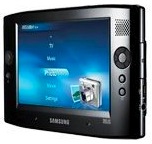

The iPhone floats in the uncharted territory between Microsoft's "ultra mobile" Windows XP Tablet PCs like the $1300 Samsung Q1, and the tiny but clumsy Windows Mobile phones with chicklet keyboards that slide out of a box that is as thick as an unabridged Russian dictionary.
Charting a New Course
The iPhone is closer to being a micro-laptop using flash RAM than a conventional smartphone. In fact, it is actually far closer to being a modern version of the 1994 Newton--which Jobs was purportedly so embittered against--than anything that Microsoft has ever released. It bears little resemblance to Windows Mobile.
Imagine the Newton, but smaller, retrofitted with a modern OS, a camera, a phone, an iPod, built in wireless, better battery life, a color screen, faster, with a finger-based touch screen... and the iPhone emerges.
While Apple's retail stores might give the iPhone an advantage in up-selling its own customers from their basic phones, it will still need to aggressively outsell existing smartphones to meet Apple 10 million sales target. What does the iPhone compete against? Here's a quick look at other phones on the market.
The iPhone’s Competition
There are few popular phones on the market near the iPhone's $500 price. Basic phones are commonly free, and smartphones typically cost between $100 and $200 with a service provider subsidy and mail in rebates.
All smartphones require a two year contract--a minimum commitment of over $2000--to qualify for the subsidy discount. Unlocked phone prices represent the actual cost of the phone without any carrier subsidy.
Additional rebates may apply to new customers. Prices differ slightly by region, and may be even lower online. Here’s what I found online at Amazon and Cingular in a recent price check.
The new Sony Ericsson P990 is listed as $700 unlocked, with no service options in the US offered by Amazon.
Like the Palm, it has a stylus driven touch screen. Its screen is half the resolution of the iPhone. It has a number button face that flips down to expose a tiny keyboard below it.
On Amazon, users complained about its software being buggy and crashing frequently. Like the iPhone, it sports premium features like a 2 Megapixel camera and WiFi wireless networking; unlike Apple’s iPhone however, the P990 supports the much faster UMTS 3G data service.
The problem with its 3G service is that it only works on European service bands. The limited 3G data service that is available in the US uses different frequencies. Similarly, it uses Tri-band GSM, not Quad-band GSM like the iPhone, giving it reduced voice coverage in the US.
Service Complexities for World Phones and UMTS 3G Data Service
GSM uses two bands in Europe (900/1800 MHz), and three in the US (850/1800/1900 MHz) for voice service; [John Kneeland pointed out that the 1800 MHz band is only used in the US by the Department of Defense].

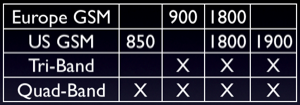

Tri-band phones work on both bands in Europe, but only two [one!] in the US. Quad-band world phones support all four, providing additional service coverage for users in the US.
High speed UMTS 3G data service is even more complicated. Existing service in Europe and elsewhere combines two bands for data uplink and downlink (2100+1900 MHz).
Unfortunately, parts of the 2100 MHz band are already in use in the US for satellite communications, and parts of the 1900 MHz band are already in use in the US for GSM networks.
Cingular has already started rolling out its own, incompatible UMTS service (850+1900 MHz) in certain US cities, and later this year T-Mobile will offer a different UMTS 3G service (2100+1700 MHz). Neither matches Europe’s (2100+1900 MHz), so both require phones specifically designed to support the oddball US formats. 
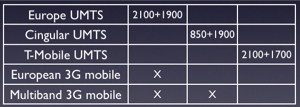




Between the limited service availability of 3G data service in the US, and the problem of different sets of frequencies in use, 3G service does not yet make a lot of sense in the US.
That’s why few US phones offer 3G service, and why those that would seem to, like the Sony Ericsson P990, won’t actually work in the US.
Higher End: Windows Mobile HTC TyTN
One of the most expensive phones commonly available is the HTC TyTN/Hermes/8525. Cingular offers it for $400 after rebate and subsidy; Amazon for $200 with service and rebates or $760 unlocked, with a $999 list price.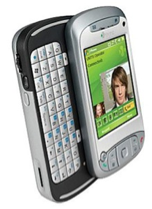

Like the Palm and other Windows Mobile Pocket PCs, it has a stylus driven touch screen. Its screen is also half the resolution of the iPhone. It has a PDA style face which slides open to reveal a QWERTY keyboard, although it’s too big for thumb typing, and too small for touch typing.
Like the iPhone, it sports premium features like a 2 Megapixel camera and WiFi wireless networking. Like the P990, it also supports UMTS 3G data service, although it works on both Europe and Cingular’s networks.
In order to do that, it packs in Multiband UMTS, as well as being Quad-band GSM like the iPhone. Support for all those networks results in a unit over twice as thick as the iPhone, but also gives it much faster Internet access when WiFi isn’t available.
The premium price and 3G features of the TyTN and similar high end Windows Mobile phones has not done much to expand Microsoft's share of the market. That's why recent offerings by vendors licensing Windows Mobile have targeted the low end of the smartphone market.
Most Windows Mobile Smartphones Aim Low
Most smartphones running Windows Mobile are conservatively featured and are priced to sell for around $100 with a carrier subsidy. Few support WiFi, and most lack a touch screen or enough memory to run many apps and store music or photos, apart from ringtones and camera phone pictures.
They are basic phones with organizer functions, often with features problematically hidden in deeply nestled pulldown menus that erase any premise of being designed for one handed use.
A big sales pitch for Windows Mobile involves mobile versions of Office apps, as if people are likely to edit Excel documents on a tiny screen.
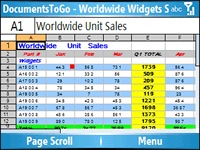




Low-end Windows Smartphones, like the $500 Samsung Blackjack and $400 Motorola Q are aimed to sell in the range of $100-200 with a contract subsidy and mail-in rebates.
These phones abandon the PDA or tiny-PC form factor of earlier WinCE devices to imitate the success and styling of the BlackBerry and Treo.
The Palm Treo and RIM BlackBerry
The loyal following of Palm Treo and RIM BlackBerry users allows those vendors to regularly introduce new models at higher price points than other phones, and then sell older models at a discount to budget customers. New Palm Treo versions typically debut at a list price of $650, while a new BlackBerry lists around $400.
With subsidy, Cingular sells the latest Treo 750 on its website for $400, while Amazon offers it for as little as $99. Older versions of the Treo are listed by Cingular at $100, or as little as $49 on Amazon. Cingular lists various BlackBerry models between $100-$200, while Amazon offers them from $70 to Free.
Palm offers a higher resolution display and more memory than most other common mobiles, making it a popular choice for users who want PDA features. 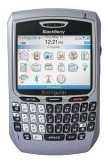

BlackBerry phones are popular among professionals addicted to the push messaging they introduced--where emails arrive immediately without the user having to stop and check--along with their thumb driven tiny keypad.
Unique features of the BlackBerry and Palm are mixing together as vendors copy each other’s strong points. The result is that many mobiles now have the familiar thumb keyboard, a small touch screen, and similar menus and features and applications.
Snooze You Lose?
The middle class phones from Palm and RIM, along with imitative offerings by Windows Mobile and Symbian licensees, all aim to sell for around $100 or less with a contract subsidy and cover a laundry list of basic features:
-
•basic camera phone
-
•simplified web browser
-
•basic PDA and sync functions
-
•text messaging and picture mail
-
•simple add-on apps like Google Maps
-
•downloadable $2 ringtones and games
They also all share Device Problems In Search of a Solution: the user interface, stability, sync, and DRM issues I like to point out as plaguing the industry.
It is therefore rather bold for Apple to introduce a phone that is priced around $500, particularly given that Apple plans to swallow up nearly 20% of the smartphone market by the end of next year. Other high end phones exist primarily to anchor a vendor’s lineup; Sony doesn’t expect its P990 to sell to a wide, mass market audience.
Distinguishing Features
Apart from 3G data service, the iPhone offers hardware features that meet or beat the fancier phones common in markets outside the US: better camera, much larger display, far more memory for storage, and WiFi support.
Where it really differs from existing US phones is in its unique OS X driven software features:
-
•a finger driven multi-touch screen with intuitive gesture shortcuts that make complex actions simple
-
•a multiple page, standard web browser with smart, resolution independent zooming
-
•a real photo and music media library, and real calendar and contact applications
-
•real 3-pane email with support for HTML mail and push accounts; support for visual voicemail
-
•tightly integrated, custom Google Maps and other apps; tight integration between phone features
-
•integration with iTunes for real media sync, not just ringtones and pay per view toy video
Critics suggesting that the iPhone is “just a fancier version” of the email and web on existing phones are being just as disingenuous as DOS users who pooh-poohed the Mac in 1984, or those who couldn’t understand why the Palm Pilot and BlackBerry could have devoted fans. It’s all about practical usability.
Good Tools Are Worth It
Existing phones are a lot like the gift box toolsets offered in discount stores: all the pieces are technically there, but it’s difficult to be productive with them when doing a serious job. The toy hammer’s head falls off every three swings and the screwdrivers strip themselves.
Using cheap tools turns out to be expensive in the end because of lost opportunity costs. Why spend $4.99 on a pretend hammer when a real hammer can be bought for $25, saving the frustrating expense of messing around with inadequate junk?
Will sticker shock be a barrier to Apple’s iPhone? That may depend on whether consumers are able to see past the ruse of phone subsidies and realize that the most expensive thing about a phone is not its hardware cost but the service fees.
Spending $2000 across two years is more pleasant with a $500 functional phone than with a toy piece of junk that may be available for free. Given that consumers already see the difference between the $500 iPod and $99 imitations, it looks like the only thing Apple has to worry about is building enough to meet demand.
Next, I’ll compare the iPhone to new phones still on the horizon, and how quickly other phones might catch up.
Have another phone to suggest in comparison? Let me know and I'll do a follow up review.
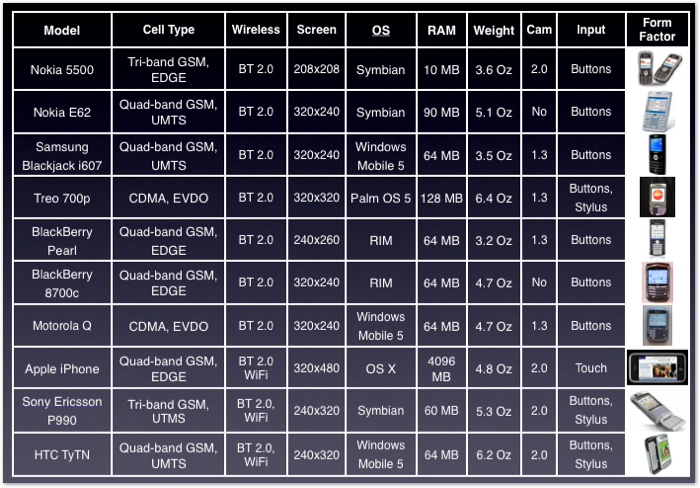
Next Articles:
This Series


 |
|
 |
|
 Del.icio.us |
Del.icio.us |
 Technorati |
About RDM :
:
Technorati |
About RDM :
:

Monday, January 22, 2007



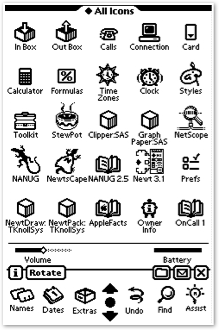
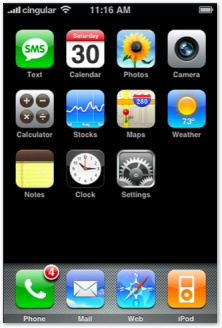
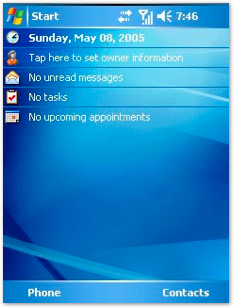
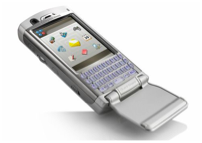
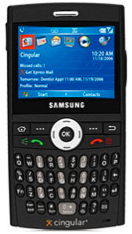


 Send Link
Send Link Reddit
Reddit NewsTrust
NewsTrust






